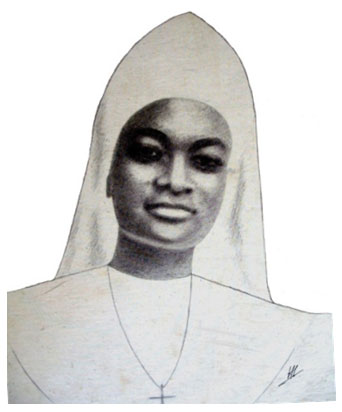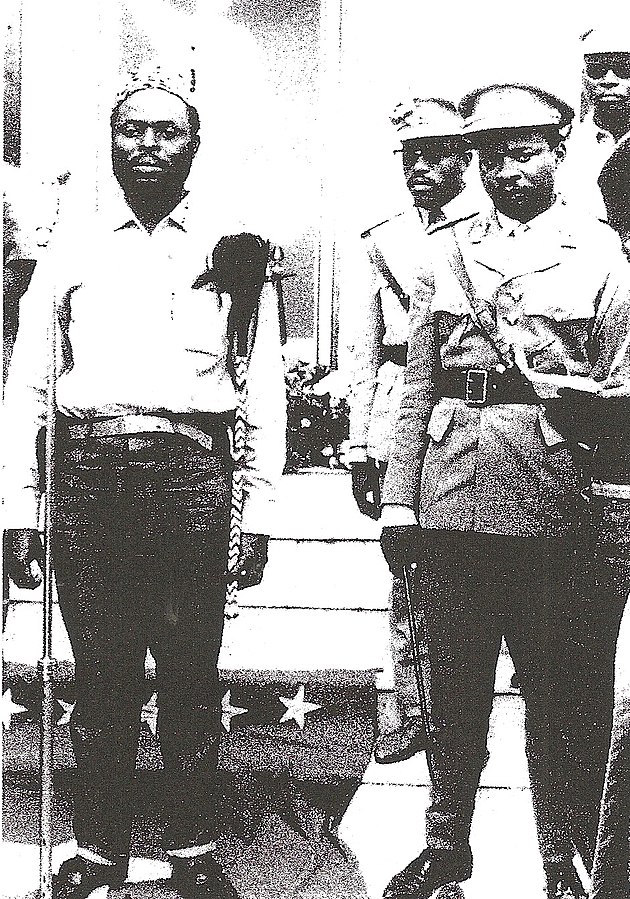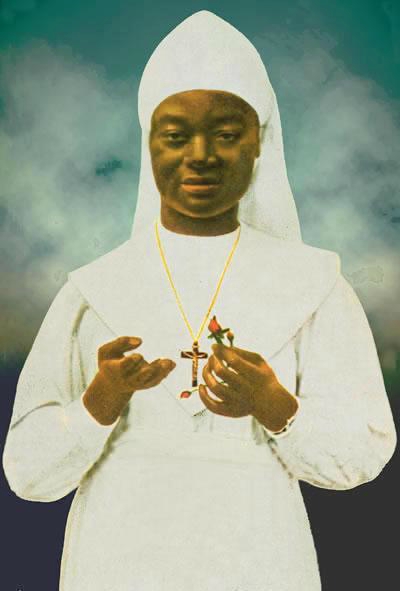 The present Soviet-Cuban aggression against the African continent has been prepared by decades of infiltration, propaganda, and communist inspired terrorist activity. The lives of the African people have been systematically disrupted, the land has been devastated, and religious and shrines of the Church have been desecrated.
The present Soviet-Cuban aggression against the African continent has been prepared by decades of infiltration, propaganda, and communist inspired terrorist activity. The lives of the African people have been systematically disrupted, the land has been devastated, and religious and shrines of the Church have been desecrated.
These assaults have at times, by way of reaction, providentially called forth great proofs of love of the Church and truly noble and transcendent counter-revolutionary triumphs. One of the most heroic and legendary of these, one which will continue to reverberate across the centuries, was written in blood by a grail woman in Northeastern Zaire. She is [Blessed Marie-Clémentine*] Sister Anuarita of Bafwabaka, faithful bride of Christ, who gave her life to preserve the kingdom of Christ in Africa without spot or stain.
The Reign Of Terror In Stanleyville
In November of 1964, the Simbas unleashed a reign of terror in Stanleyville, now called Kisangani (northeastern Zaire). Commissars Mulele and Gbenye terrorized the eastern province, seizing hostages and brutalizing the people.
On November 3, Gbenye declared in a radio broadcast that he still held many white hostages and would kill them without exception if the central government in Leopoldville, now Kinshasa, did not halt the advance of its troops. The situation in Stanleyville worsened daily, producing serious shortages of food and water. Looters and thieves continuously roamed the neighborhoods, violating the homes of the people. Everywhere, the enemies of the tyrants were summarily condemned to die; the death sentences were executed by forcing the victims to drink gasoline and then blowing them up alive…
The Belgians Save The Hostages
As scattered news of the reign of terror filtered to the outside world, the Belgians determined to send in 600 airborne troops. On November 24, around 6 o’clock in the morning, U.S. Air Force transport planes dropped the parachutists over Stanleyville.

Christophe Gbenye, President of the Republic People’s Republic of Congo, and General Nicholas Olenga at the Lumumba Monument in Stanleyville, summer 1964. Gbenye is standing atop of the flag of the defunct Republic of the Congo (Léopoldville).
Besides themselves with fury, the Simbas hastily pushed 250 hostages into Sergeant Kintele Avenue and made them kneel down. “If the Belgians come, you will all die,” shouted “Major” Babu, a former boxer and drug addict who commanded the rebel troops. However, as he shouted “kill them!”, the Belgians assaulted the street and nearly all the hostages were saved. This time the Simbas were defeated.
The Death Dance Continues
The withdrawal of the Simbas was terrible. Missionaries were assassinated, nuns raped, missions burned down in the jungle. In Paulis, more than 4,000 Africans were executed by firing squads. Almost everyone who knew how to read and write was tortured to death. An old missionary had all of his bones broken, one by one, by rifle stocks. Twenty women died under terrible tortures.
The Rebels Arrive In Bafwabaka
On Sunday, November 29, a rebel group commanded by “Colonel” Olombe reached the missionary outpost of Bafwabaka. There he would find a convent of nuns of African origin, the Sisters of the Holy Family, consisting of 36 nuns, novices and aspirants. The community is called “Jamaa Taratifu” in Swahili.
On that day, one of the members of the community, Sister Clementine Anuarita, was celebrating her twenty-fifth birthday. It was going to be her last…
Sister Anuarita: “The Sunshine At Your Disposal”
Sister Anuarita was baptized at the age of six, receiving the name of Alfonsine. Those who knew her in her village say that she was a joyful, vivacious, and dedicated child. They recall that in Wamba, where she attended elementary school, she had the habit of visiting the poor and the sick.
 As was common among African children, she began while still quite young helping her parents at home: drawing water from the well, gathering wood, and cooking a few things on the stove. Like her companions of the same age, she feared the snakes she encountered on the way to the well, and enjoyed playing with puppies and goats in the village. She was a typical African child.
As was common among African children, she began while still quite young helping her parents at home: drawing water from the well, gathering wood, and cooking a few things on the stove. Like her companions of the same age, she feared the snakes she encountered on the way to the well, and enjoyed playing with puppies and goats in the village. She was a typical African child.
But Alfonsine Anuarita was uncommonly intelligent. Because of this, after leaving elementary school, she went to high school in Bafwabaka with the Sisters of the Holy Family. Convent life must have exerted a strong attraction over her, for in 1955 she was already an aspirant. In 1959, she made her first vows, receiving the name of Sister Clementine. She began working as a teacher, and after a complementary course in 1963, became director of the girls’ boarding school where she herself had been a student a few years earlier.
Within the community of sisters she was known as “the sunshine at your disposal.” She was always serene, joyful, and ready for whatever was necessary. After school, she went with the sisters in charge of maintenance to help them pick up wood, to fish in the NepokoRiver, and to wash and iron clothes. On many Sundays, the sisters and students were able to enjoy cake and other deserts. In the notebook of Sister Anuarita – now part of the material of her canonization process in Rome – cake and desert recipes can be found besides texts of meditation and her personal notes. To bring joy to the boarding students, she always managed to find new recipes somewhere. On that November 29, Sister Anuarita had prepared something for her twenty-fifth birthday. But everything would turn out differently…
“I’d Rather Die Than Commit Such A Sin!”
Suddenly, from the jungle came the Simbas in drab olive trucks. They stopped in front of the convent, their brakes squeaking. The rebels, most of whom were drunk or high on hashish, staggered toward the convent, shouting and waving automatic rifles, long knives, and spears in the air. At “Colonel” Olombe’s orders, they pushed the nuns into the trucks, and in a few minutes the column resumed its march. Sister Anuarita tried to assuage the fear of the other sisters with a few words.
After some miles of travel through the jungle, the vehicles halted at a Simba camp. Other trucks drove up. The Mulele soldiery launched out against the sisters, snatching their pectoral crosses from them and uttering savage and obscene insults…

Map showing the territory controlled by the Simba (red) and Kwilu (yellow) rebels, 1964. Photo by Don-kun, Uwe Dedering
Finally, they resume the painful trip through the jungle, arriving by nightfall in Isoro. “Colonel” Olombe ordered everyone out of the trucks. Approaching Sister Anuarita, he said in a hoarse voice: “Tonight you will be my woman.” Anuarita shook her head, signifying “no, never.” The furious “colonel” struck her violently and then pulled her to himself. Anuarita resisted with all her strength, shouting: “This would be a grave sin. I’d rather have you kill me!”
Held as she was by brute force, she turned to her sister: “Pray with me, help me. I’d rather die than commit such a sin!” Olombe tried to pull her into his car, but the nun defended herself with all her strength. “Let me go! I am ready to die here. I will never be your woman!”
“Death Is Swallowed Up In Victory”
The “colonel” went mad. He dealt heavy blows to her face and body with his rifle stock, causing her to fall to the ground, her face covered with blood. He knew no mercy, striking like a madman the dilacerated body inside the white habit. The voice of Sister Anuarita became weaker: “Go on beating, I have made my decision.” And then breathing forth her last sigh, she whispered: “May God forgive you, you don’t know what you do…”
The situation of the “colonel” was becoming disagreeable. He had just “finished” with a defenseless young woman and this – even in the eyes of the rebels – was not an act of heroism. Forcing a smile, he quipped: “Comrades, I killed an enemy of the Revolution. Two rebels step forward with their spears, piercing Sister Anuarita’s body three or four times. In addition, Olombe shot the dead sister in the head.
At first, Anuarita’s sisters were petrified. Then during her martyrdom, one of them began to change the “Magnificat.” Trembling, and with tears in their eyes, the other joined her: “…and my spirit hath rejoiced in God my Saviour.”
 The rebels, disconcerted and speechless, ran away in a desperate flight. “Sister Anuarita has protected us,” one of the nuns exclaimed. “The martyrs of Uganda and Saint Mary Goretti have always been her models. Now she has followed both of them,” they wrote on November 30, 1964, the eve of All Saints’ Day.
The rebels, disconcerted and speechless, ran away in a desperate flight. “Sister Anuarita has protected us,” one of the nuns exclaimed. “The martyrs of Uganda and Saint Mary Goretti have always been her models. Now she has followed both of them,” they wrote on November 30, 1964, the eve of All Saints’ Day.
If the Church in eastern Zaire is able to celebrate its hundredth jubilee in 1980, Africa will have a new Saint. The missionary Bishop of Catarzi Uvira (in the South of the Kivu province) affirmed: “Sister Anuarita will be for us a powerful intercessor with God, so that He may help us to finally attain peace in this country.”
Taken from Crusade For A Christian Civilization, #2, 1980, pgs. 25-27.
*She was beatified on August 15, 1985 by Pope John Paul II during his visit to Africa. She was the first Bantu woman elevated to the altars. Her memorial is 1 December.









